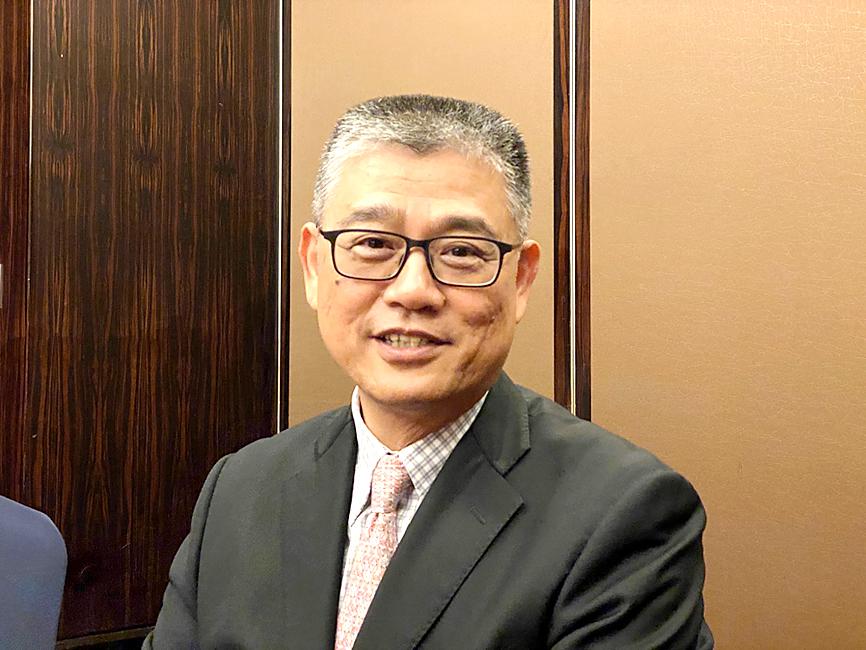Rugged PC vendor Getac Technology Corp (神基) yesterday forecast that its sales would increase “by double digits” this year, despite supply chain difficulties.
During the company’s online shareholders’ meeting, Getac chairman James Hwang (黃明漢) said that he is “pinning his hopes on the return of the US and Europe commercial market” for the second half of this year.
“The company is targeting 6 to 12 percent growth in revenue year-on-year in 2021,” Hwang said. “It’s tough, but doable.”

Photo: CNA
Getac, which was founded in 1989, produces rugged computers, mechanical components, aerospace fasteners and automotive components.
The rugged computers are designed for use in difficult environments such as in the military, medical and transportation sectors in which devices need to be water, dust and impact proof.
Hwang forecast increased demand for the company’s rugged computers as Europe and the US reopen for business.
“In the second quarter we are beginning to see more orders and an increase in demand from military and police users in Europe and the US,” Hwang said. “I remain upbeat about the second half of 2021.”
Hwang said that he expects rugged computer sales to grow by 8 to 10 percent for the whole of this year.
“Components shortage is still the wild card,” he said.
While demand for automotive components is being affected by the semiconductor shortage, Hwang said the company still hopes to reach double-digit percentage growth in sales in the segment this year.
“We have seen some delays in the orders, but demand is still there,” he said.
Hwang said that he expects sales of mechanical and electrical parts to remain mostly flat.
As raw material prices and logistical costs increase, Getac is in “rolling discussions” with customers about price increases, Hwang said, adding that most of the company’s customers are aware of the issues.
“Some products have to go up in price,” Hwang said. “After good communication with clients, they understand they must absorb some of the cost increases.”
Getac reported revenue of NT$2.27 billion (US$81.05 million) for last month, up 1.82 percent year-on-year.
Revenue in the first six months of the year was NT$14.91 billion, up 14.72 percent year-on-year.

Taiwan Semiconductor Manufacturing Co (TSMC, 台積電) last week recorded an increase in the number of shareholders to the highest in almost eight months, despite its share price falling 3.38 percent from the previous week, Taiwan Stock Exchange data released on Saturday showed. As of Friday, TSMC had 1.88 million shareholders, the most since the week of April 25 and an increase of 31,870 from the previous week, the data showed. The number of shareholders jumped despite a drop of NT$50 (US$1.59), or 3.38 percent, in TSMC’s share price from a week earlier to NT$1,430, as investors took profits from their earlier gains

In a high-security Shenzhen laboratory, Chinese scientists have built what Washington has spent years trying to prevent: a prototype of a machine capable of producing the cutting-edge semiconductor chips that power artificial intelligence (AI), smartphones and weapons central to Western military dominance, Reuters has learned. Completed early this year and undergoing testing, the prototype fills nearly an entire factory floor. It was built by a team of former engineers from Dutch semiconductor giant ASML who reverse-engineered the company’s extreme ultraviolet lithography (EUV) machines, according to two people with knowledge of the project. EUV machines sit at the heart of a technological Cold

Taiwan’s long-term economic competitiveness will hinge not only on national champions like Taiwan Semiconductor Manufacturing Co. (TSMC, 台積電) but also on the widespread adoption of artificial intelligence (AI) and other emerging technologies, a US-based scholar has said. At a lecture in Taipei on Tuesday, Jeffrey Ding, assistant professor of political science at the George Washington University and author of "Technology and the Rise of Great Powers," argued that historical experience shows that general-purpose technologies (GPTs) — such as electricity, computers and now AI — shape long-term economic advantages through their diffusion across the broader economy. "What really matters is not who pioneers

TAIWAN VALUE CHAIN: Foxtron is to fully own Luxgen following the transaction and it plans to launch a new electric model, the Foxtron Bria, in Taiwan next year Yulon Motor Co (裕隆汽車) yesterday said that its board of directors approved the disposal of its electric vehicle (EV) unit, Luxgen Motor Co (納智捷汽車), to Foxtron Vehicle Technologies Co (鴻華先進) for NT$787.6 million (US$24.98 million). Foxtron, a half-half joint venture between Yulon affiliate Hua-Chuang Automobile Information Technical Center Co (華創車電) and Hon Hai Precision Industry Co (鴻海精密), expects to wrap up the deal in the first quarter of next year. Foxtron would fully own Luxgen following the transaction, including five car distributing companies, outlets and all employees. The deal is subject to the approval of the Fair Trade Commission, Foxtron said. “Foxtron will be